Business Communication Report: Culture and Listening Skills
VerifiedAdded on 2022/09/25
|5
|1089
|21
Report
AI Summary
This business communication report delves into the significance of organizational culture and its influence on internal and external interactions. It explores how a positive culture, characterized by shared values and open communication, fosters effective information flow and employee relationships, while a poor culture can lead to communication barriers and reduced productivity. The report also examines the importance of listening skills, highlighting gender differences in communication styles and how understanding these differences can improve workplace interactions. It emphasizes the need for appropriate communication channels to overcome misunderstandings and ensure effective message delivery. Ultimately, the report underscores the critical role of communication in achieving organizational success by fostering mutual understanding and minimizing conflicts.
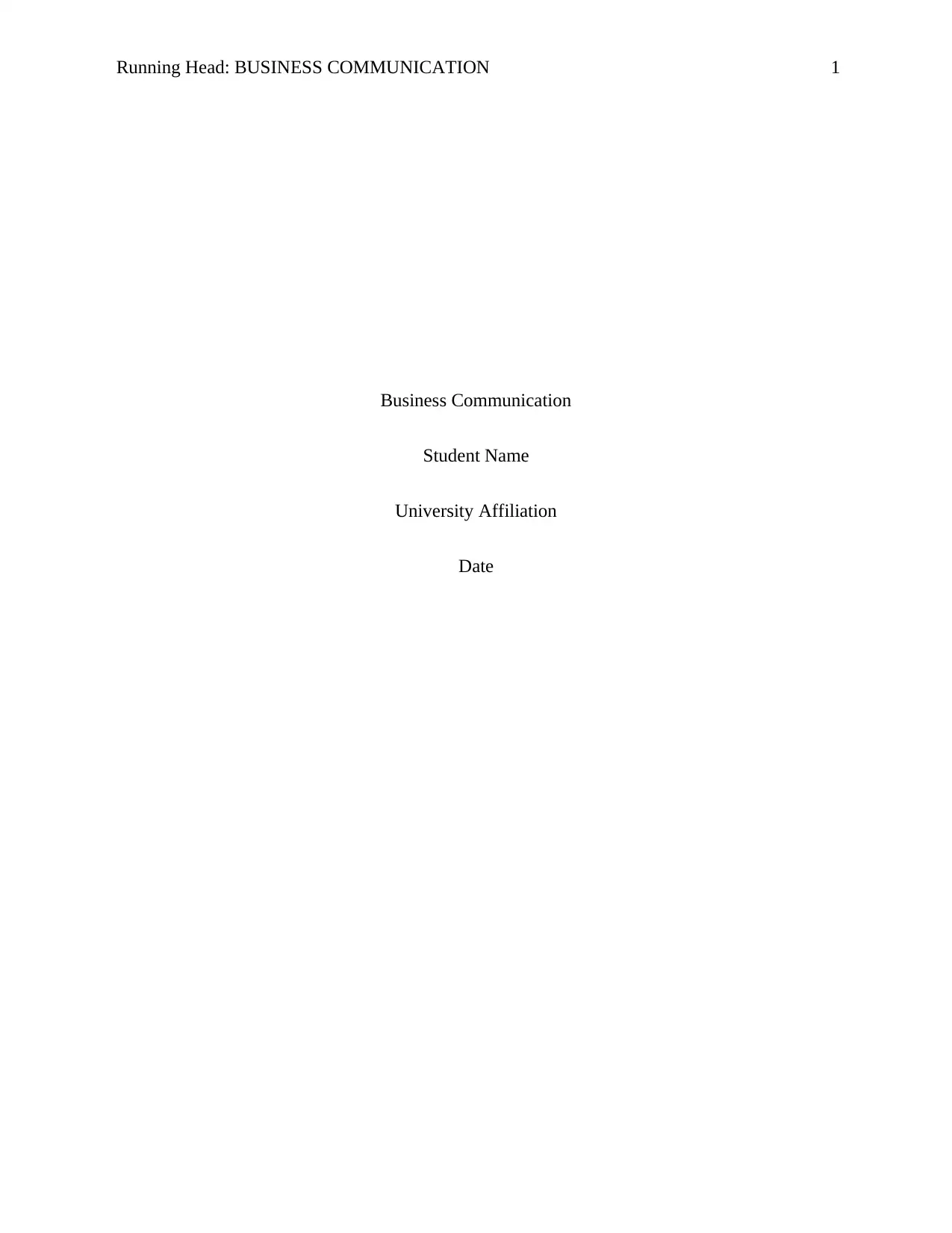
Running Head: BUSINESS COMMUNICATION 1
Business Communication
Student Name
University Affiliation
Date
Business Communication
Student Name
University Affiliation
Date
Paraphrase This Document
Need a fresh take? Get an instant paraphrase of this document with our AI Paraphraser
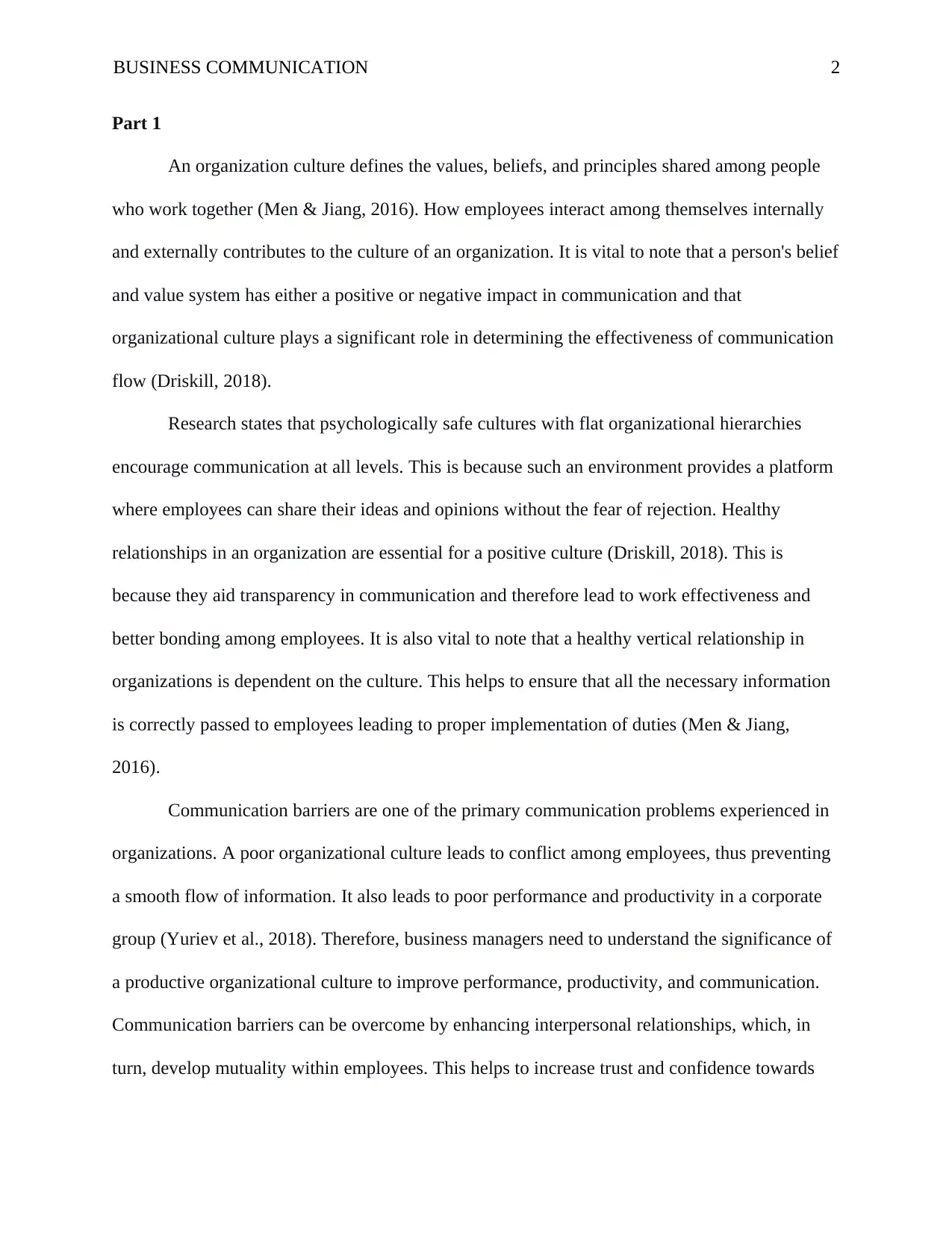
BUSINESS COMMUNICATION 2
Part 1
An organization culture defines the values, beliefs, and principles shared among people
who work together (Men & Jiang, 2016). How employees interact among themselves internally
and externally contributes to the culture of an organization. It is vital to note that a person's belief
and value system has either a positive or negative impact in communication and that
organizational culture plays a significant role in determining the effectiveness of communication
flow (Driskill, 2018).
Research states that psychologically safe cultures with flat organizational hierarchies
encourage communication at all levels. This is because such an environment provides a platform
where employees can share their ideas and opinions without the fear of rejection. Healthy
relationships in an organization are essential for a positive culture (Driskill, 2018). This is
because they aid transparency in communication and therefore lead to work effectiveness and
better bonding among employees. It is also vital to note that a healthy vertical relationship in
organizations is dependent on the culture. This helps to ensure that all the necessary information
is correctly passed to employees leading to proper implementation of duties (Men & Jiang,
2016).
Communication barriers are one of the primary communication problems experienced in
organizations. A poor organizational culture leads to conflict among employees, thus preventing
a smooth flow of information. It also leads to poor performance and productivity in a corporate
group (Yuriev et al., 2018). Therefore, business managers need to understand the significance of
a productive organizational culture to improve performance, productivity, and communication.
Communication barriers can be overcome by enhancing interpersonal relationships, which, in
turn, develop mutuality within employees. This helps to increase trust and confidence towards
Part 1
An organization culture defines the values, beliefs, and principles shared among people
who work together (Men & Jiang, 2016). How employees interact among themselves internally
and externally contributes to the culture of an organization. It is vital to note that a person's belief
and value system has either a positive or negative impact in communication and that
organizational culture plays a significant role in determining the effectiveness of communication
flow (Driskill, 2018).
Research states that psychologically safe cultures with flat organizational hierarchies
encourage communication at all levels. This is because such an environment provides a platform
where employees can share their ideas and opinions without the fear of rejection. Healthy
relationships in an organization are essential for a positive culture (Driskill, 2018). This is
because they aid transparency in communication and therefore lead to work effectiveness and
better bonding among employees. It is also vital to note that a healthy vertical relationship in
organizations is dependent on the culture. This helps to ensure that all the necessary information
is correctly passed to employees leading to proper implementation of duties (Men & Jiang,
2016).
Communication barriers are one of the primary communication problems experienced in
organizations. A poor organizational culture leads to conflict among employees, thus preventing
a smooth flow of information. It also leads to poor performance and productivity in a corporate
group (Yuriev et al., 2018). Therefore, business managers need to understand the significance of
a productive organizational culture to improve performance, productivity, and communication.
Communication barriers can be overcome by enhancing interpersonal relationships, which, in
turn, develop mutuality within employees. This helps to increase trust and confidence towards
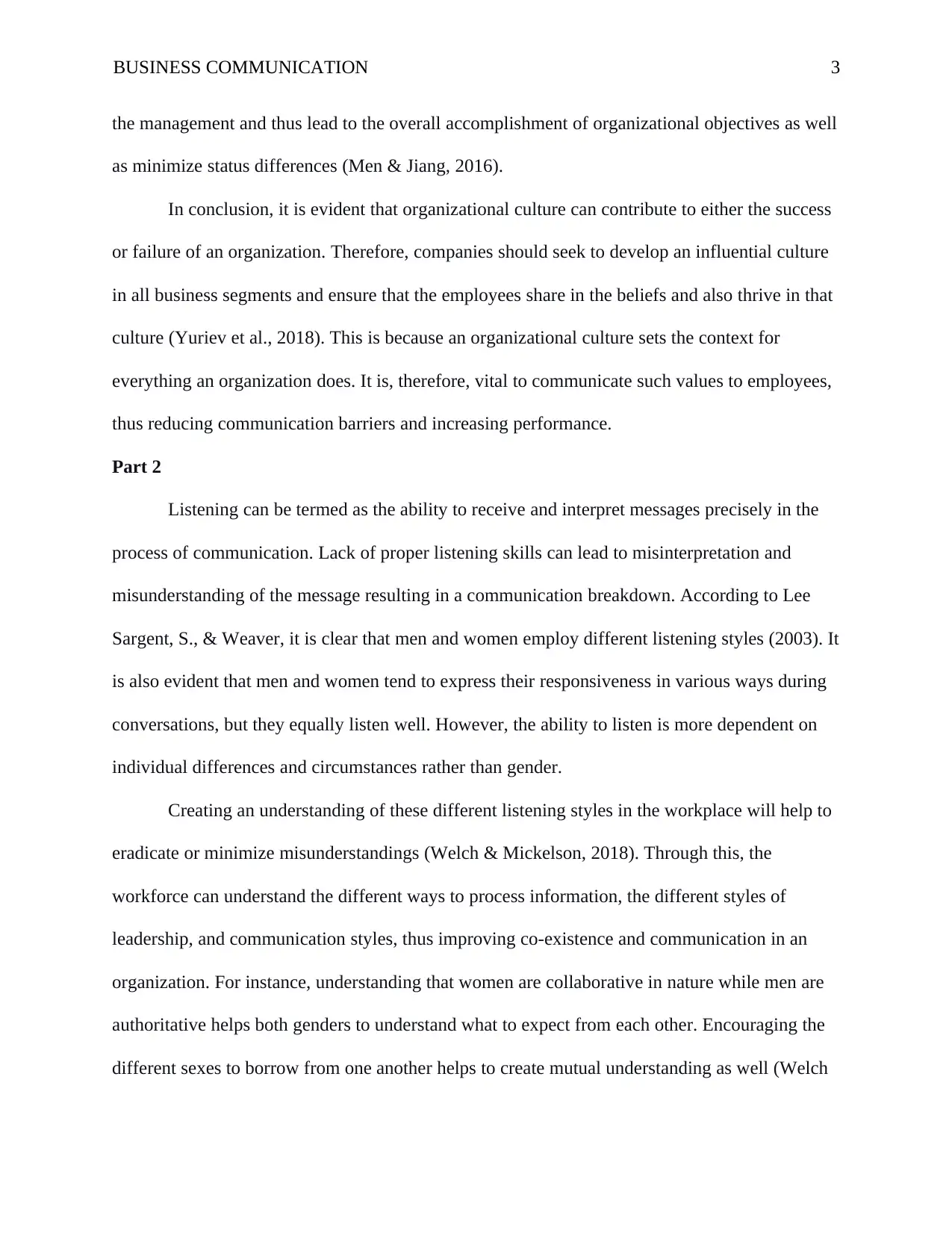
BUSINESS COMMUNICATION 3
the management and thus lead to the overall accomplishment of organizational objectives as well
as minimize status differences (Men & Jiang, 2016).
In conclusion, it is evident that organizational culture can contribute to either the success
or failure of an organization. Therefore, companies should seek to develop an influential culture
in all business segments and ensure that the employees share in the beliefs and also thrive in that
culture (Yuriev et al., 2018). This is because an organizational culture sets the context for
everything an organization does. It is, therefore, vital to communicate such values to employees,
thus reducing communication barriers and increasing performance.
Part 2
Listening can be termed as the ability to receive and interpret messages precisely in the
process of communication. Lack of proper listening skills can lead to misinterpretation and
misunderstanding of the message resulting in a communication breakdown. According to Lee
Sargent, S., & Weaver, it is clear that men and women employ different listening styles (2003). It
is also evident that men and women tend to express their responsiveness in various ways during
conversations, but they equally listen well. However, the ability to listen is more dependent on
individual differences and circumstances rather than gender.
Creating an understanding of these different listening styles in the workplace will help to
eradicate or minimize misunderstandings (Welch & Mickelson, 2018). Through this, the
workforce can understand the different ways to process information, the different styles of
leadership, and communication styles, thus improving co-existence and communication in an
organization. For instance, understanding that women are collaborative in nature while men are
authoritative helps both genders to understand what to expect from each other. Encouraging the
different sexes to borrow from one another helps to create mutual understanding as well (Welch
the management and thus lead to the overall accomplishment of organizational objectives as well
as minimize status differences (Men & Jiang, 2016).
In conclusion, it is evident that organizational culture can contribute to either the success
or failure of an organization. Therefore, companies should seek to develop an influential culture
in all business segments and ensure that the employees share in the beliefs and also thrive in that
culture (Yuriev et al., 2018). This is because an organizational culture sets the context for
everything an organization does. It is, therefore, vital to communicate such values to employees,
thus reducing communication barriers and increasing performance.
Part 2
Listening can be termed as the ability to receive and interpret messages precisely in the
process of communication. Lack of proper listening skills can lead to misinterpretation and
misunderstanding of the message resulting in a communication breakdown. According to Lee
Sargent, S., & Weaver, it is clear that men and women employ different listening styles (2003). It
is also evident that men and women tend to express their responsiveness in various ways during
conversations, but they equally listen well. However, the ability to listen is more dependent on
individual differences and circumstances rather than gender.
Creating an understanding of these different listening styles in the workplace will help to
eradicate or minimize misunderstandings (Welch & Mickelson, 2018). Through this, the
workforce can understand the different ways to process information, the different styles of
leadership, and communication styles, thus improving co-existence and communication in an
organization. For instance, understanding that women are collaborative in nature while men are
authoritative helps both genders to understand what to expect from each other. Encouraging the
different sexes to borrow from one another helps to create mutual understanding as well (Welch
⊘ This is a preview!⊘
Do you want full access?
Subscribe today to unlock all pages.

Trusted by 1+ million students worldwide
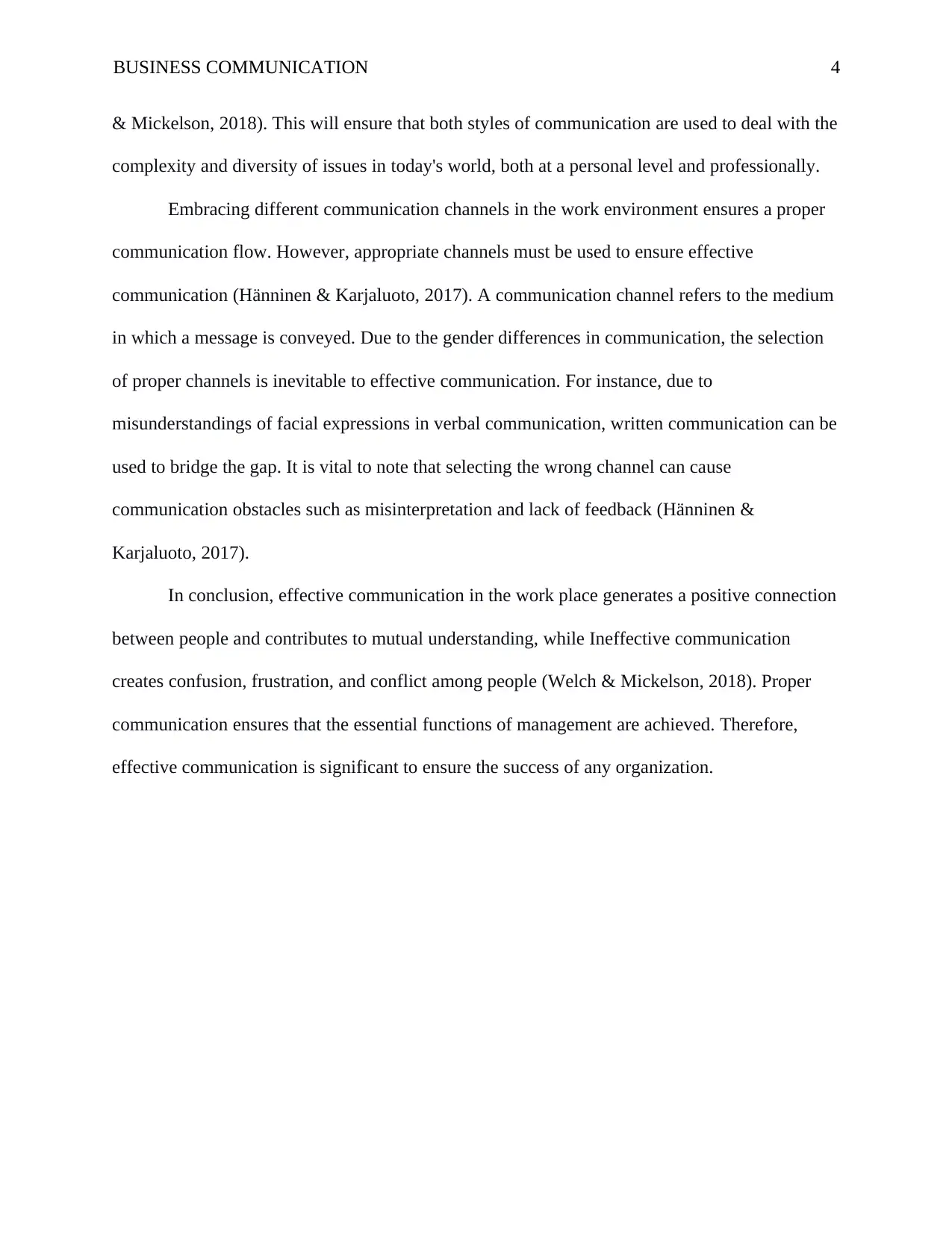
BUSINESS COMMUNICATION 4
& Mickelson, 2018). This will ensure that both styles of communication are used to deal with the
complexity and diversity of issues in today's world, both at a personal level and professionally.
Embracing different communication channels in the work environment ensures a proper
communication flow. However, appropriate channels must be used to ensure effective
communication (Hänninen & Karjaluoto, 2017). A communication channel refers to the medium
in which a message is conveyed. Due to the gender differences in communication, the selection
of proper channels is inevitable to effective communication. For instance, due to
misunderstandings of facial expressions in verbal communication, written communication can be
used to bridge the gap. It is vital to note that selecting the wrong channel can cause
communication obstacles such as misinterpretation and lack of feedback (Hänninen &
Karjaluoto, 2017).
In conclusion, effective communication in the work place generates a positive connection
between people and contributes to mutual understanding, while Ineffective communication
creates confusion, frustration, and conflict among people (Welch & Mickelson, 2018). Proper
communication ensures that the essential functions of management are achieved. Therefore,
effective communication is significant to ensure the success of any organization.
& Mickelson, 2018). This will ensure that both styles of communication are used to deal with the
complexity and diversity of issues in today's world, both at a personal level and professionally.
Embracing different communication channels in the work environment ensures a proper
communication flow. However, appropriate channels must be used to ensure effective
communication (Hänninen & Karjaluoto, 2017). A communication channel refers to the medium
in which a message is conveyed. Due to the gender differences in communication, the selection
of proper channels is inevitable to effective communication. For instance, due to
misunderstandings of facial expressions in verbal communication, written communication can be
used to bridge the gap. It is vital to note that selecting the wrong channel can cause
communication obstacles such as misinterpretation and lack of feedback (Hänninen &
Karjaluoto, 2017).
In conclusion, effective communication in the work place generates a positive connection
between people and contributes to mutual understanding, while Ineffective communication
creates confusion, frustration, and conflict among people (Welch & Mickelson, 2018). Proper
communication ensures that the essential functions of management are achieved. Therefore,
effective communication is significant to ensure the success of any organization.
Paraphrase This Document
Need a fresh take? Get an instant paraphrase of this document with our AI Paraphraser
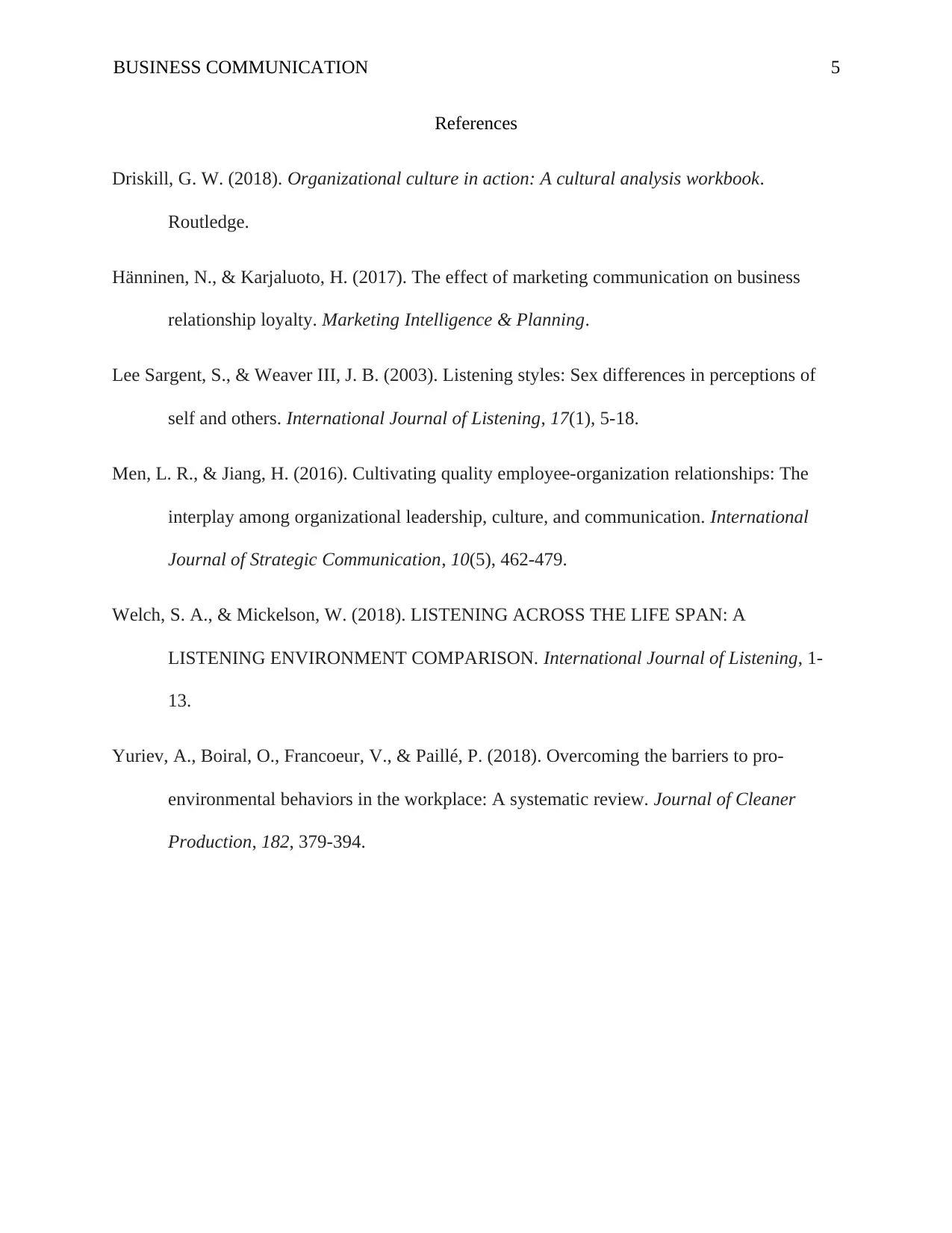
BUSINESS COMMUNICATION 5
References
Driskill, G. W. (2018). Organizational culture in action: A cultural analysis workbook.
Routledge.
Hänninen, N., & Karjaluoto, H. (2017). The effect of marketing communication on business
relationship loyalty. Marketing Intelligence & Planning.
Lee Sargent, S., & Weaver III, J. B. (2003). Listening styles: Sex differences in perceptions of
self and others. International Journal of Listening, 17(1), 5-18.
Men, L. R., & Jiang, H. (2016). Cultivating quality employee-organization relationships: The
interplay among organizational leadership, culture, and communication. International
Journal of Strategic Communication, 10(5), 462-479.
Welch, S. A., & Mickelson, W. (2018). LISTENING ACROSS THE LIFE SPAN: A
LISTENING ENVIRONMENT COMPARISON. International Journal of Listening, 1-
13.
Yuriev, A., Boiral, O., Francoeur, V., & Paillé, P. (2018). Overcoming the barriers to pro-
environmental behaviors in the workplace: A systematic review. Journal of Cleaner
Production, 182, 379-394.
References
Driskill, G. W. (2018). Organizational culture in action: A cultural analysis workbook.
Routledge.
Hänninen, N., & Karjaluoto, H. (2017). The effect of marketing communication on business
relationship loyalty. Marketing Intelligence & Planning.
Lee Sargent, S., & Weaver III, J. B. (2003). Listening styles: Sex differences in perceptions of
self and others. International Journal of Listening, 17(1), 5-18.
Men, L. R., & Jiang, H. (2016). Cultivating quality employee-organization relationships: The
interplay among organizational leadership, culture, and communication. International
Journal of Strategic Communication, 10(5), 462-479.
Welch, S. A., & Mickelson, W. (2018). LISTENING ACROSS THE LIFE SPAN: A
LISTENING ENVIRONMENT COMPARISON. International Journal of Listening, 1-
13.
Yuriev, A., Boiral, O., Francoeur, V., & Paillé, P. (2018). Overcoming the barriers to pro-
environmental behaviors in the workplace: A systematic review. Journal of Cleaner
Production, 182, 379-394.
1 out of 5
Related Documents
Your All-in-One AI-Powered Toolkit for Academic Success.
+13062052269
info@desklib.com
Available 24*7 on WhatsApp / Email
![[object Object]](/_next/static/media/star-bottom.7253800d.svg)
Unlock your academic potential
Copyright © 2020–2025 A2Z Services. All Rights Reserved. Developed and managed by ZUCOL.



